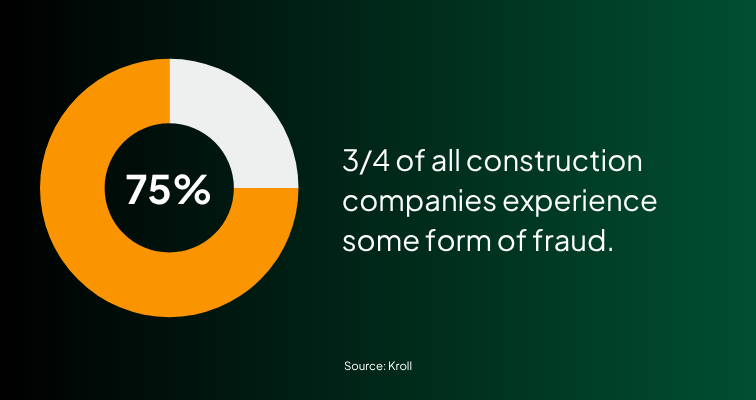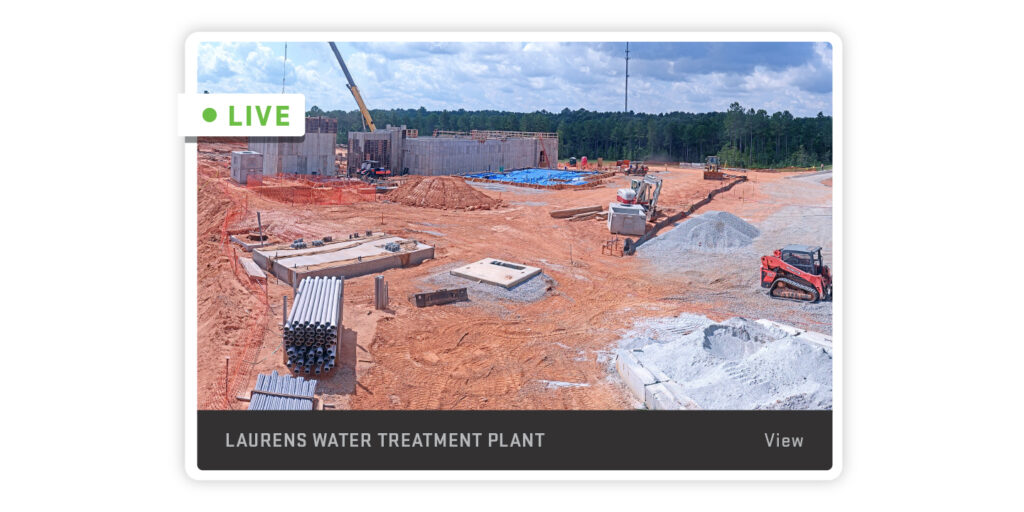Fraud plagues all industries; construction is no exception. And on the jobsite, construction fraud takes many forms. It can happen at any point during a project, from the bidding process to onsite project execution and payment for services.
According to Kroll’s 2015/16 Global Fraud Report, the overall prevalence of construction fraud was 75%, meaning that three-quarters of all construction companies experienced some form of fraud. Additionally, the construction sector had the highest rate of regulatory or compliance breaches (18%) of any other industry covered in the survey, and the second highest for theft of physical assets (36%) and vendor or procurement fraud (24%).

Worse yet, the industry has the highest increase in fraud exposure of any sector (92%).
You don’t have to settle for construction or contractor fraud. Today’s article outlines the various schemes thieves use and ways to combat the increasingly sophisticated strategies that contribute to the billions of dollars lost each year.
What Exactly is Construction Fraud?
Let’s take a look at what construction fraud means and how it affects everyone in the construction process. Construction fraud includes deceptive activities designed to gain some sort of financial advantage during projects, leaving innocent parties paying for work that never happened or materials that contractors never used.
Fraud schemes can be simple or sophisticated, and they range from bid rigging to falsifying payment applications or substituting substandard materials. Project owners, contractors, subcontractors, and suppliers all suffer when fraudulent contractors inflate costs or charge for labor never performed.
The consequences of allowing fraud to happen include projects going over budget, legal action from government agencies, and damage to business reputation. Certified fraud examiners report that these schemes cost the industry billions, $98 billion in 2023 to be exact, with expenses ultimately passed to homeowners, property investors, and consumers.
Protect yourself by verifying a contractor’s expertise, insurance, and track record through the Better Business Bureau (BBB.org) before falling victim to these common fraud schemes.
Common Types of Construction Fraud
Construction fraud takes many forms, each designed to extract money without delivering the promised value. Understanding these common fraud schemes helps project owners and honest contractors identify and prevent them before significant financial damage occurs.
Bid Rigging and Collusion
Bid rigging represents one of the most damaging forms of construction fraud, directly undermining the competitive bidding process that should ensure fair prices. In these schemes, dishonest contractors coordinate their actions to manipulate who wins contracts, often at inflated costs that harm project owners.
Fraudulent contractors achieve rigging through various techniques, such as bid suppression (where some contractors agree not to bid), complementary bidding (submitting intentionally high bids to make another contractor’s bid look reasonable), and bid rotation (taking turns being the lowest bidder). These coordinated efforts eliminate the competition that typically keeps construction costs reasonable and ensures quality work.
Red Flags:
- Identical proposal errors
- Sudden price drops
- Predictable winning patterns
- Qualified bidders declining unexpectedly
- All bids near the budget
Falsified Payment Applications and Invoicing
Dishonest contractors often manipulate payment applications by inflating labor costs, billing for unperformed work, or charging improper wage rates to extract more money from project owners. This fraud typically involves falsifying invoices for materials never delivered or labor hours never worked, directly increasing project costs while reducing the actual value delivered.
Red Flags:
- Invoices exceeding the original budget
- Missing supporting documentation
- Altered employee timecards
- Vague work descriptions
- Inconsistent billing patterns
Change Order Fraud
Change order fraud occurs when contractors submit false or inflated modifications to the original contract, charging for materials or work that was either unnecessary or never completed. The construction process naturally involves changes, but this vulnerability creates opportunities for fraudulent contractors to introduce unjustified costs that project owners often approve without proper scrutiny.
Red Flags:
- Unusually frequent changes
- Poor change documentation
- Vague cost explanations
- Rushed approval requests
- No competitive pricing
Product Substitution
Product substitution fraud involves contractors billing for high-quality materials while actually installing inferior, substandard materials and pocketing the price difference. This deceptive practice costs more money upfront and often leads to expensive repairs, reduced property value, and potential safety issues when low-quality materials fail prematurely.
Red Flags:
- Mismatched material labels
- Restricted inspection access
- Altered material documentation
- Missing quality certificates
- Unmarked material deliveries
Time Overcharging
On the jobsite, time is money. Time theft happens when workers are not honest about when they enter or leave the jobsite. For example, workers may clock in their co-workers as a favor to help them avoid the consequences of being late to work. Additionally, when workers waste time, they impact productivity, which is costly to the construction firm.
According to The New York Times, one construction firm would falsely report workers were on the jobsite when they weren’t, and subcontracted labor and carpenter foremen without client approval. They ended up having to pay over $7 million for the faulty timesheets, thanks to the client’s ability to provide evidence.
Construction cameras with security recording can help prevent such time theft by keeping a visual record of when workers enter and leave a jobsite, and what they do while on the job. PMs can use the remote live-viewing features to watch activity in real-time and prevent further loss.
Red Flags:
- Altered timecard records
- Hours always match budget
- Supervisor-completed timecards
- “Ghost” employees listed
- Sudden labor cost spikes
- Inconsistent worker presence
- Missing daily logs
- Identical daily hours
Theft of Materials and Equipment
Construction sites are particularly vulnerable to theft due to their open nature, temporary security measures, and the high value of materials and equipment. Material robbery involves both internal theft (by employees or subcontractors) and external theft (by outsiders), with stolen materials often resold or used on other projects while project owners still pay the full price for replacements.
Red Flags:
- Inconsistent inventory records
- Missing delivery documentation
- Equipment disappearing overnight
- Materials ordered repeatedly
- Unexplained weekend access
False Insurance Claims
Construction fraud extends to insurance matters when workers or contractors submit fraudulent claims for injuries or damages that never occurred or happened outside the jobsite. These deceptive practices involve fabricating accidents, exaggerating minor injuries, or claiming off-site incidents occurred during work hours, all designed to extract insurance money while raising premiums and creating legal liability for construction firms.
Red Flags:
- No witnesses present
- Inconsistent accident reports
- Claims during off-hours
- History of similar claims
- Delayed injury reporting
- Reluctance toward investigation
- Missing security footage
- Vague incident details
Several contractors nationwide fall victim to fraudulent insurance claims each year, but construction cameras help project managers stay vigilant. In one New York case, an investment of a few hundred dollars on cameras prevented millions of dollars in false damage claims.
Proactive Measures to Prevent Construction Fraud
Protecting your construction project from fraud depends on your multi-layered approach that addresses vulnerabilities before malicious actors can exploit them. With a few preventative measures, project owners significantly reduce their risk of falling victim to the typical fraud schemes that plague the construction industry. Those measures include:
- Due Diligence and Vetting: Conduct thorough background checks on all contractors, verifying licenses, insurance coverage, and business references before signing any contracts.
- Formal and Transparent Processes: Establish strict bidding procedures with clear communication channels and detailed written contracts that specify payment schedules and change order protocols.
- Strong Internal Controls: Implement segregation of duties where different individuals handle approvals, payments, and verifications to prevent any single person from controlling the entire process.
- Detailed Documentation: Maintain accurate records of all transactions, including materials delivered, labor performed, and services completed to compare against invoices and payment applications.
- Technology Solutions: Utilize construction management software and jobsite cameras that provide continuous visual documentation, deterring theft while capturing evidence of any fraudulent activities.
- Fraud Awareness Training: Educate all parties involved about common fraud schemes, red flags to watch for, and proper reporting mechanisms when identifying suspicious activities.
- Regular Audits and Inspections: Perform scheduled and surprise inspections to monitor for irregularities in billing, payments, materials quality, and labor distribution.
- Data Analysis: Compare actual costs against budgeted amounts and investigate any unusual patterns, particularly in areas known to be vulnerable to fraudulent schemes.
The best protection against construction fraud combines vigilance with systematic controls and documentation throughout the entire construction process. By making fraud more difficult to commit and easier to detect, you create a jobsite environment where dishonest contractors and workers are less likely to attempt deceptive practices.
Enhance Fraud Prevention Through Visual Jobsite Insights
Combating fraudulent activities depends on modern solutions that create accountability and transparency throughout every phase of the construction process. Visual documentation serves as both a powerful deterrent and an irrefutable record when questions arise about material quality, labor hours, or site security breaches.

Construction cameras offer project owners a practical defense against the costly schemes outlined above, providing real-time visibility and permanent evidence of jobsite activities.
See how construction cameras from TrueLook strengthen your fraud prevention strategy. Reach out today for a custom quote!

